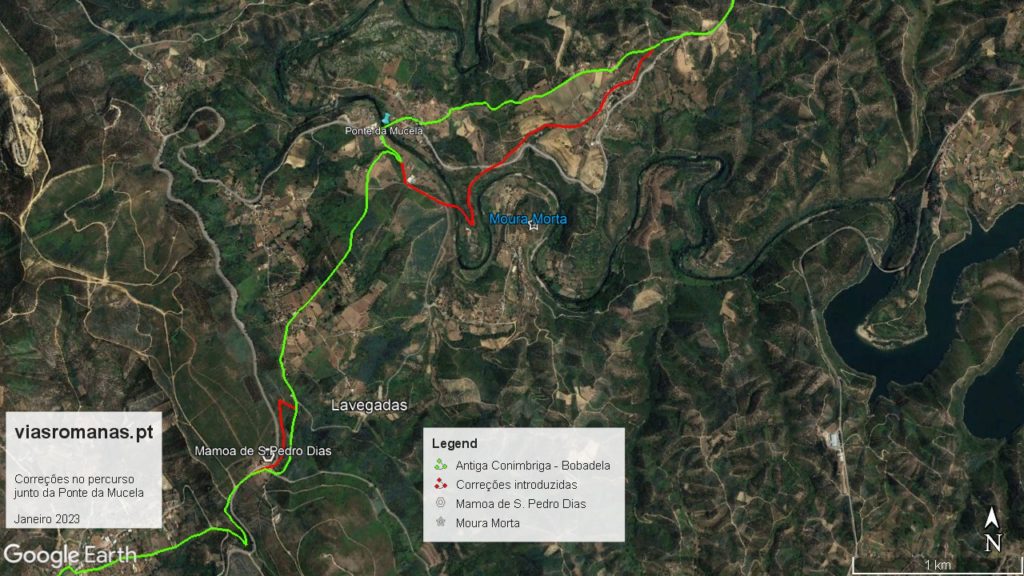One of the main itineraries that crossed the portuguese territory had origin in the city of Conímbriga, crossing the «Beira Alta» region towards the river Douro, passing in Bobadela, Celorico da Beira (where it crosses the Mondego River), and through the territory of the Civitas Aravorum (Marialva), linked to important crossings of the Douro, one in Quinta de Vesúvio/Sra. da Ribeira and another on Monte Meão/Foz do Sabor (and not for Salamanca as had been said).
This itinerary has been associated to the so called “Estrada da Beira” (Beira Road) that starts in the city Coimbra and links to Celorico da Beira, but the direction of this route clearly indicates that its origin was in Conímbriga and not in Coimbra. A possible branch connecting to Coimbra, although not impossible, does not seem feasible, since the derivations of the route connect not to Coimbra but to fluvial ports in the Mondego (namely Porto da Raiva and Penacova). Although there are tracks on the other bank, these seem to be heading northwest and not towards Coimbra, which further weakens this hypothesis. Inevitably, these tracks end up crossing the route coming from Viseu towards Coimbra, and thus can follow this way that city, but the various inflections in the way are not consistent with the existence of an independent track linking Coimbra to Bobadela.
If there are doubts about the final destinations of the road, the place where the road crossed the River Alva is unanimous, pointing to the area of «Ponte da Mucela», a traditional crossing point since the Middle Ages. In the book Monarquia Lusitana, Fray Francisco Brandão transcribes an inscription that was placed on the medieval bridge, commemorating its construction in 1295, during the reign of King Dinis. However, the identification of some Roman stones that were reused in the medieval construction supports the hypothesis of an earlier Roman bridge, perhaps further downstream, near the Roman settlement of Moura Morta, where the crossing is much easier.

The settlement is located on a meander of the River Alva, which surrounds the settlement on all sides but the southern side, from where the site was accessed. However, the strong cliffs on the other bank make it impossible to cross at the base of the settlement. However, between this place and the bridge, there is a more favourable area to cross the river, taking advantage of a hump that exists there to start the ascent of the hillside in gentle steps. In fact, the passage through this area might not even require the construction of a bridge, in which case, the Roman ashlars could have come from the village of Moura Morta itself, which is only about 1 km from the current bridge.
But independently of the question if the existence of a Roman bridge, everything points for the crossing here of the river for the reasons explained above and also because this tracing is in line with the mile sequence between Conímbriga and Bobadela. In fact, the distance from Conímbriga to the Alva River through the proposed route totals 29 miles (typical value between stages), and the 27th mile points to the top of the mountain gateway of Serra do Bidueiro, next to megalithic monument called «Mamoa of S. Pedro Dias» (a pilgrimage to this site takes place everyear), showing once again the great antiquity of this route, at least as a footpath.
This correction also allows us to match the sequence of miles with the only known station in this route, located in Eira Velha (unfortunately recently destroyed by the construction of the Coimbra-Tomar section of the A13 highway, another avoidable destruction of Roman structures next to the road), which is located 22 miles from Rio Alva and seven miles from Conímbriga. This track continued westwards until the town of Soure (eventually a river port of the Mondego), where a milestone was found.
Regarding milestones, there are only three on this route, all of them found near Seia, at the crossing with another major road, the route from Viseu to São Romão castrum (c. Seia), so we do not know for sure which of the two routes was marked by milestones.
The only one that still keeps part of the inscription is from Imperor Maximiano, indicating XXI miles, a distance compatible with Bobadela and Celorico da Beira, but which seems more appropriate to the latter, in this case marking the distance to the Mondego River. It is currently located in the garden of a rural tourism house in Paços da Serra. Recently, another milestone (anepigraphic) was identified near the Santa Comba cemetery, which is most probably in situ, and is therefore decisive to adjust the milestone sequence. The third one was identified nearby, in the village of Vila Chã, and it was reused as support of a balcony of a house, whose morphology and proximity to Santa Comba supports the hypothesis that it is in fact another milestone of this route.
Returning to the crossing of the Alva river at Mucela, the Moura Morta site does not have any sign of a previous Iron Age occupation, which means that it was established by the romans, eventually to control this passage (possibly a statio). However, until the settlement is excavated, nothing more can be added.